Overcoming earth / ground rod risks

Earth rods are installed with incredible frequency. Currently the majority of electrical earthing systems will include the usage of earth rods. On the face of it that prompts an entirely reasonable question, if everyone is doing then what’s the problem with earth rods. It’s a question put to Earthing Services all the time, usually by people who have either a vested interest in engineers installing earth rods, or by those who have been installing them for a long time and have just had a sinking feeling when Earthing Services suggested that it may not be such a great idea.
In an attempt to provide an accessible overview to the question the following video was developed.
The HSE, The Construction (Design & Management) Regulations (CDM 2015), and reducing health and safety risks
Earth rods are usually driven into the ground from surface level. Even if thorough information gathering activities have been undertaken the driving of an earth rod remains a “blind” activity. The expansion of our demands for electricity in all manner of infrastructure and construction activities has seen the need for earthing systems increase to support them. The number of reportable incidents resultant from earth rod installations has increased and unfortunately the varieties of injuries and damage caused by the activities are entirely avoidable.
A recent report by a Safety Inspector detailed concerns about the use of earth rods:
- Danger to personnel and infrastructure from hitting unknown cables, pipes or other subterranean elements deleterious to health that may further impact dependent parties.
- Danger to installation teams using heavy hammer-type tools, both in terms of RSI and incidental injury from a mis-hit.
- Danger to installation teams using breaker-type hydraulic power tools, even if abiding by exposure limits.
- Slips, trips and falls from unseen power lines feeding breaker-type hydraulic power tools.
- Hearing damage from the use of breaker-type hydraulic tools both from the device itself and onsite generators.
- Danger to site/structure/dependent users, passersby or trespassers in the event of an earth fault where a deteriorated earth rod(s) is insufficient to effectively manage the fault.
Considering the above in light of the obligation to adopt the safest ways of working on behalf of installation operatives, users, and future users of a site necessitates the identification of better methods of working.
Deterioration and impacts on performance
The most commonly installed variety of earth rod is copperbonded steel-cored. The copper coating is around the sides of the rod is thin, usually about 250 microns. Copper is a reliable variety of conductor, and is not as prone to deterioration as steel. Far stronger than copper, steel provides a solid core that can be driven into the ground, whereas a solid copper rod would not only be significantly more expensive, but would most likely buckle if driven into the ground. Combined they benefit from the best attributes of each metal, but also sadly, the worst attributes.
If the copper coating is damaged it will leave the steel exposed. Furthermore the steel tip and end of the rod will remain exposed. Steel will deteriorate in line with the local acidity, alkalinity, salinity and toxicity levels.
The image to the right demonstrates the remains of a 1.2m copperbonded steel earth rod 3 months after installation. As you can see all that is left is the threaded end, with the whole piece about 50mm long. The quality of the rod is beyond dispute, it was produced by one of the leading global manufacturers with UL accreditation. In this instance the local ground mass had higher salinity levels due to its coastal location. The problem is not the quality of the product, it’s simply the inherent weakness of the product-type.
In the event of a fault current event the earth rod would have provided no protection. Take a look again at the photograph and consider that an earthing system is much like a second parachute: when you need it to work it has to work or people can die. As earthing systems are infrequently checked, if at all, they need to be able to withstand any kind of environment, and on as permanent a basis as can be achieved. Earthing Services products and methods are permanent, and protect against deterioration.

Examples of some of our earth rod alternatives
Earthing Services has a range of products and methods that clients rely on to avoid the hazards and liabilities associated with earth rods. The following provide a couple of popular examples, but anyone interested in adopting improved working methods should get in touch to discuss their needs as our team will be able to support the identification of the optimal product solution.
By using our products and methods all of these hazards, and many more, are removed and do not need to be considered in RAMS. Furthermore on an insurance level the liability risks are also removed.
What about when earth rods are unavoidable?
When it comes to the products and methods enjoyed by Earthing Services’ clients it’s passingly rare for rods to be required. That being said some specifications insist upon the usage of vertical electrodes. Sometimes a highly restricted footprint necessitates the exclusive usage of vertical conductors. Sometimes it’s the most practical way to penetrate substrata with optimal resistivity. Whilst a number of products within the portfolio can be installed vertically if rods are insisted upon then using them should attempt to consider the following approach:
- Conduct exhaustive documentary reviews and surface level detection methods to establish beyond all reasonable doubt that there are no underground services.
- Hand dig using safety tools and all necessary Personal Protective Equipment below the usual depth of services (verify with local utilities),
- Augur around the rod location to create sufficient room for earth rod encapsulation. For deep rods a drilling contractor may be required.
- Install rod and install Conducrete into the excavated hole.
- Locate rod in the centre of the excavation.
